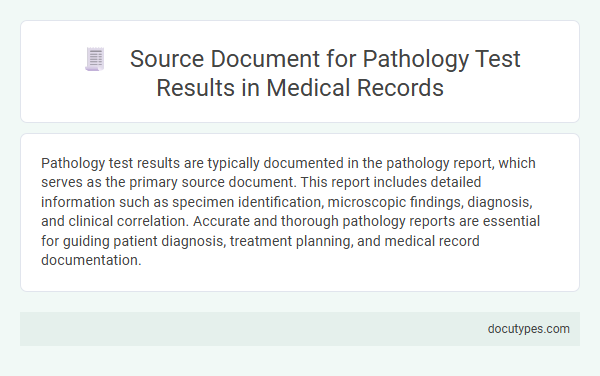Pathology test results are typically documented in the pathology report, which serves as the primary source document. This report includes detailed information such as specimen identification, microscopic findings, diagnosis, and clinical correlation. Accurate and thorough pathology reports are essential for guiding patient diagnosis, treatment planning, and medical record documentation.
Introduction to Source Documents in Pathology
Source documents in pathology serve as the primary records for all pathology test results. These documents ensure accuracy and traceability in patient diagnosis and treatment.
- Pathology Report - This is the main source document containing detailed findings from tissue, blood, or other specimen analyses.
- Laboratory Information System (LIS) - A digital platform that stores and manages pathology test data and generates official results.
- Specimen Collection Forms - Documents that record key information about the sample collection process, essential for test validity.
Importance of Accurate Pathology Test Documentation
Pathology test results are primarily documented in source documents such as pathology reports and laboratory information system records. These documents provide detailed descriptions of specimen analysis, diagnosis, and test outcomes essential for patient care.
Accurate pathology test documentation is crucial for ensuring reliable diagnosis and effective treatment planning. It minimizes errors, supports clinical decision-making, and enhances communication among healthcare providers.
Types of Source Documents for Pathology Results
Source documents for pathology test results primarily include laboratory reports, biopsy reports, and surgical pathology reports. Laboratory reports provide detailed analysis of blood, tissue, or fluid samples processed in the lab. Biopsy and surgical pathology reports contain microscopic examination findings essential for diagnosing diseases and guiding treatment plans.
Standard Format for Pathology Reports
What source document is used for pathology test results in medical practice? Pathology test results are primarily documented in pathology reports. These reports follow a standard format to ensure clarity, consistency, and accuracy in communicating diagnostic information.
What is the standard format for pathology reports used in medical documentation? The standard format typically includes patient identification, specimen description, microscopic and macroscopic findings, diagnosis, and comments or recommendations. This structured format helps healthcare providers interpret the results effectively for diagnosis and treatment planning.
Essential Data Elements in Pathology Test Records
The primary source document for pathology test results is the pathology report, which contains detailed analysis and diagnostic findings of tissue or fluid samples. Essential data elements in pathology test records include patient identification, specimen type, test performed, microscopic description, and final diagnosis. Accurate documentation of these elements ensures effective communication between laboratories and healthcare providers for patient care.
Integration of Pathology Results into Electronic Medical Records
| Source Document for Pathology Test Results | Pathology test results originate from pathology reports generated by clinical laboratories. These reports include detailed findings from tissue analysis, biopsy examinations, and laboratory tests essential for diagnosing diseases. |
|---|---|
| Content of Pathology Reports | Reports typically contain macroscopic and microscopic observations, immunohistochemistry results, molecular test data, and diagnostic interpretations. This data guides clinical decision-making and treatment planning. |
| Integration into Electronic Medical Records (EMRs) | Pathology results are integrated into EMRs through standardized interfaces, using Health Level Seven (HL7) messaging protocols and Fast Healthcare Interoperability Resources (FHIR) standards. This ensures seamless data transfer from laboratories to patient records in your healthcare system. |
| Benefits of Integration | Embedding pathology data into EMRs improves accessibility, enhances clinical workflow, facilitates longitudinal patient monitoring, and supports clinical decision support systems by providing timely and accurate diagnostic information. |
| Data Security and Compliance | Integration processes comply with regulatory standards such as HIPAA, ensuring patient data confidentiality and integrity during transmission and storage within EMRs. |
Legal and Regulatory Requirements for Pathology Documentation
Pathology test results are primarily documented using the original laboratory report issued by accredited pathology laboratories. This source document serves as the foundational evidence for diagnosis, treatment planning, and medical record accuracy.
Legal and regulatory requirements mandate that pathology documentation must be complete, accurate, and securely maintained to ensure patient safety and support clinical decisions. Regulatory agencies such as the Clinical Laboratory Improvement Amendments (CLIA) and the College of American Pathologists (CAP) establish stringent standards for the validation and retention of pathology test results. Failure to comply with these requirements can result in legal liabilities, compromised patient care, and loss of accreditation for healthcare facilities.
Challenges in Pathology Source Document Management
Pathology test results are primarily sourced from laboratory information systems and electronic health records that document specimen analysis and diagnostic findings. Efficient management of these source documents is critical for accurate diagnosis, treatment planning, and compliance with regulatory standards.
Challenges in pathology source document management include data fragmentation, inconsistent documentation formats, and secure access control.
- Data Fragmentation - Pathology data often resides in multiple systems, causing difficulties in consolidation and comprehensive review.
- Inconsistent Documentation Formats - Variability in report formats and terminologies disrupts seamless data integration and interpretation.
- Secure Access Control - Ensuring patient confidentiality while providing timely access to authorized personnel demands sophisticated security protocols.
Best Practices for Ensuring Data Integrity in Pathology Records
Pathology test results originate from source documents such as laboratory reports, histopathology slides, and digital imaging records. These documents provide primary data crucial for accurate diagnosis and treatment planning in medical practice.
Best practices for ensuring data integrity in pathology records include implementing standardized documentation protocols and utilizing secure electronic health record (EHR) systems. Regular audits and validation checks help maintain accuracy and prevent transcription errors in pathology data.
What Source Document Is Used for Pathology Test Results? Infographic

